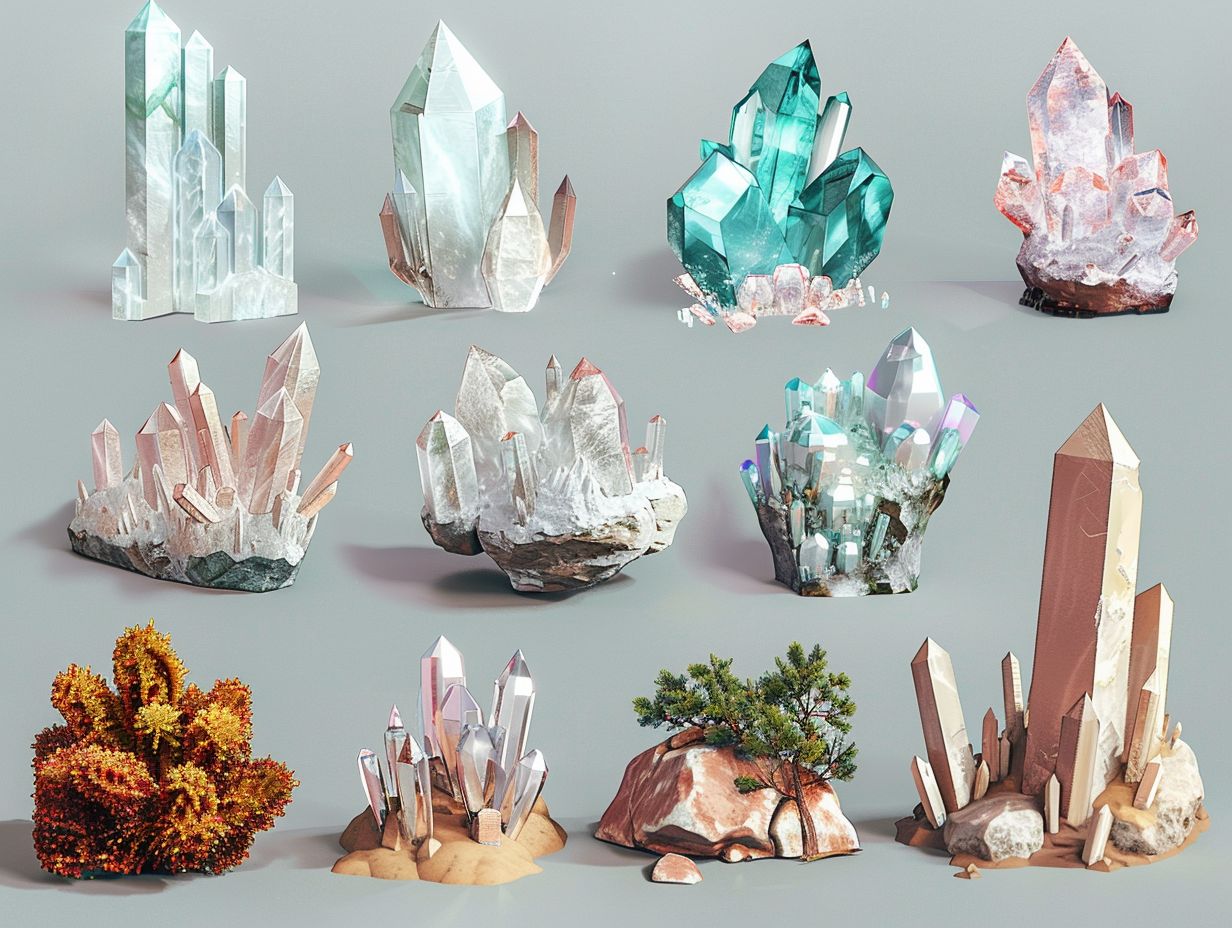
Exploring Crystal Forms: How Different Shapes Influence Energy
The fascinating world of crystals and how their shapes can impact energy will be explored in this content.
Various forms of crystals, from cubic to triclinic, will be discussed to uncover how each shape influences the flow of energy. The significance of symmetry, amplification, channeling, and absorption in relation to crystal shapes will be explored, along with the different types of crystals, such as natural, cut, and tumbled stones.
The content will also cover how to harness the power of crystal shapes to enhance energy through intention, placement, meditation, rituals, and even jewelry. Readers are invited to join the journey of exploration and give the power toment with crystals.
What Are the Different Shapes of Crystals?
Crystals exhibit a variety of shapes, each distinct and carrying its own significance. These shapes are determined by the crystal’s internal arrangement of molecules and structure.
The assortment of crystal shapes serves as an intriguing aspect of crystallography. Each shape displays intricate geometric patterns and symmetrical arrangements that characterize different crystal systems and classes. Whether it’s the defined, angular edges of cubic crystals or the graceful, elongated forms of monoclinic crystals, every shape reflects the atomic structure and bonding forces within the crystal lattice.
Studying these crystal shapes provides researchers with valuable insights into the physical properties and behaviors of different crystal structures. This research contributes to advancements in materials science and technology.
1. Cubic
Cubic crystals are known for their symmetrical and geometric shape, with equal dimensions along three axes at right angles to each other.
The distinct structural properties of cubic crystals make them easily recognizable shapes in crystallography. The symmetry of cubic crystals facilitates the efficient packing of atoms or ions within the crystal lattice, leading to a high level of order and stability. This structural stability is significant in various crystal systems, such as the simple cubic, body-centered cubic, and face-centered cubic systems. The symmetrical characteristics of cubic crystals are also crucial in determining their optical, electrical, and thermal properties, which make them valuable for a wide range of applications.
2. Hexagonal
Hexagonal crystals have a six-sided shape with internal structures that align with hexagonal symmetry, forming distinct geometric patterns. These crystals are a defining feature of the hexagonal crystal system, which has three equal axes at 120-degree angles and one axis perpendicular to the plane of the other three. The hexagonal lattice in these crystals shows a high degree of symmetry, with repetitive patterns that mirror the organization of atoms or molecules in the crystal structure. This regular arrangement contributes to the fundamental presence of hexagonal shapes in various natural and synthetic materials, highlighting their inherent stability and efficient packing structure.
3. Tetragonal
Tetragonal crystals are characterized by a four-sided shape where two sides are longer or shorter than the other two, displaying unique geometric symmetry. This specific geometric nature results in distinctive crystallographic patterns for tetragonal crystals, defined by perpendicular axes of varying lengths that create a symmetry unique to this crystal system.
Tetragonal crystals are categorized based on their symmetry and lattice structures, with similarities to cubic crystals noted in their three-dimensional arrangement symmetry. The geometric symmetry of tetragonal crystals contributes to their distinct optical properties and physical characteristics, rendering them valuable in a range of scientific and industrial applications.
4. Orthorhombic
Orthorhombic crystals are characterized by a rectangular prism shape with three unequal axes positioned at right angles to each other, displaying notable crystallographic symmetry.
The structural characteristics of orthorhombic crystals are determined by the lattice parameters a, b, and c, corresponding to the length of each axis. This crystal system is distinct due to the absence of perpendicular axes with equal lengths and angles, contributing to its unique properties.
In orthorhombic crystallography, lattice points create a lattice where each point represents an identical atom or group of atoms. This precise arrangement enables the prediction of specific crystal faces, making orthorhombic crystals valuable in various scientific and industrial applications.
5. Monoclinic
Monoclinic crystals exhibit a parallelogram shape with unequal axes and one axis perpendicular to the other two, showcasing unique crystallographic symmetry.
These distinct structural characteristics give monoclinic crystals their defining inclined angles, causing a triclinic distortion. The crystal system of monoclinic crystals is characterized by a base-centered lattice with angles that are not 90 degrees. This crystal system presents a specific combination of axial lengths and angles, resulting in a slanted lattice structure that sets it apart from other crystal systems.
The properties of monoclinic crystals make them valuable in various applications, including materials science, geology, and pharmaceuticals.
6. Triclinic
Triclinic crystals have a rhombic shape with unequal axes and no right angles, demonstrating intricate crystallographic symmetry.
This crystal system features three axes of different lengths meeting at oblique angles. In triclinic crystals, the lattice parameters a, b, and c are all unique, adding a higher level of complexity compared to other crystal systems. Due to their lack of symmetry, triclinic crystals possess the lowest level of symmetry among all crystal classes.
The internal structure of triclinic crystals presents an asymmetric arrangement of atoms, resulting in a wide range of optical properties and refractive indices. Understanding the distinctive characteristics of triclinic crystals holds importance in various fields such as mineralogy, material science, and geology.
How Do Crystal Shapes Influence Energy?
The shapes of crystals play a significant role in influencing energy fields as they possess the capability to amplify, channel, absorb, and reflect various energies.
For example, a crystal shaped like a pyramid is thought to direct energy upwards, forming a connection between the energies of the earth and the universe. Conversely, a crystal in the shape of a sphere is recognized for its ability to radiate energy in all directions, fostering a harmonious energy flow within a given space.
Crystals such as quartz, with a hexagonal structure, are valued for their capacity to magnify energy vibrations, which makes them popular options for manifestation practices. Understanding crystallography and the interactions between different crystal shapes and vibrational frequencies can assist individuals in utilizing crystals for purposes like healing, protection, and spiritual development.
1. Symmetry and Balance
The symmetry and balance of crystal shapes contribute to the harmonization of energies, promoting a sense of equilibrium and vibrational alignment.
When crystal shapes possess symmetrical patterns, they have the ability to enhance the flow of energy and create a harmonious environment. The geometric precision of these crystals plays a crucial role in maintaining balance within a space, allowing for the alignment of energies to support overall well-being.
By interacting with these balanced shapes, individuals can experience a profound sense of coherence and attunement with the surrounding vibrations, fostering a state of energetic equilibrium that positively impacts both the mind and body.
2. Amplification of Energy
Certain crystal shapes possess a natural ability to enhance energy frequencies, amplifying the resonance and vibrational effects in their surroundings.
For example, pyramids are recognized for their capacity to focus energy at the apex, establishing a potent channel for increased vibrations. This concentrated flow of energy aids in clarifying intentions and effectively manifesting desires.
Conversely, spheres release energy uniformly in all directions, fostering a harmonious energy equilibrium within a given space. The geometric accuracy of crystal shapes is pivotal in their interaction with energetic fields, enabling them to direct, diffuse, or amplify vibrations as needed.
3. Channeling of Energy
Crystal shapes serve as conduits for channeling energy flows, directing and concentrating energetic forces toward specific intentions or purposes. Through their unique geometric configurations, crystals possess distinct properties that enable them to harness and amplify various energies. The specific shape of a crystal can determine the way energy flows through it, allowing for focused intentions during energy work or healing practices.
For example, a pointed crystal shape, such as a quartz point, is often used to direct energy in a specific direction or towards a particular chakra. On the other hand, a circular or spherical crystal shape promotes the flow of energy in a harmonious and balanced manner, ideal for overall energy alignment and purification.
4. Absorption and Reflection of Energy
Specific crystal shapes possess the ability to absorb and reflect energy vibrations, affecting the energetic environment through their distinct structural properties.
Hexagonal crystals, for instance, can absorb energy from various sources like sunlight, sound waves, or emotional frequencies. The atomic arrangement in these crystals enables them to vibrate at specific frequencies, increasing their ability to engage with the energetic field.
Conversely, cubic crystals, with their symmetrical structure, excel at reflecting energy back into the environment, resulting in a harmonizing and balancing impact. The varied geometry of crystal shapes plays a crucial role in determining how they interact and resonate with different vibrational frequencies in their surroundings.
What Are the Different Types of Crystals?
Crystals are available in various forms, such as natural specimens, cut and polished stones, tumbled pieces, crystal grids, and exquisite jewelry.
These different types of crystals cater to various preferences and purposes. Natural specimens highlight the raw beauty and energy of the earth, while cut and polished stones provide a more refined appearance. Tumbled pieces, known for their smooth edges, are commonly utilized for their calming properties. Crystal grids involve combining multiple crystals in specific patterns to enhance their energies, and jewelry enables individuals to carry the healing benefits of crystals with them wherever they go. Each type of crystal formation serves a distinctive function, whether for decoration, meditation, or energy balancing.
1. Natural Crystals
Natural crystals are raw mineral formations that possess metaphysical properties and are commonly utilized in gemstone therapy and sacred geometry practices.
These ancient formations contain unique mineral compositions that contribute to their healing energies. Each crystal emits specific frequencies that interact with the body’s energy fields, helping to promote balance and harmonize vibrations. It is believed that the geometric arrangements of natural crystals enhance their energetic effects, creating a sacred and potent aura.
Understanding the varied properties of crystals enables individuals to harness their potential for physical, emotional, and spiritual well-being. From quartz to amethyst, each crystal presents a distinct energy that can aid in personal growth and transformation.
2. Cut and Polished Crystals
Cut and polished crystals undergo shaping and refining processes to enhance their visual appeal, clarity, and light-refracting properties. During the shaping process, the rough cuts and imperfections of the raw crystals are meticulously smoothed out to create a flawless surface that maximizes light reflection. Faceting plays a crucial role in how light interacts with the crystal, with each precisely angled facet strategically placed to optimize the refraction and dispersion of light. This meticulous attention to detail results in a mesmerizing play of colors and patterns within the crystal, captivating the viewer with its brilliance and depth. The final polish further enhances the clarity and transparency of the crystal, allowing its inherent beauty to shine through in all its glory.
3. Tumbled Stones
Tumbled stones are small, polished crystals appreciated for their gentle energies, making them suitable for activities such as chakra balancing, meditation, and energy harmonization.
These stones possess not only visual appeal but also unique properties that can enhance spiritual practices. During meditation, tumbled stones are thought to assist in quieting the mind and fostering a feeling of calmness. Each stone’s distinct vibrations are believed to correspond with different chakras, helping to align and balance the body’s energy centers. Many individuals use tumbled stones to establish a peaceful atmosphere, fostering feelings of well-being and tranquility in their surroundings.
4. Crystal Grids
Crystal grids involve arranging crystals in specific patterns to amplify intentions, enhance energy flow, and promote purity and harmonization of energies. These intricate arrangements are not merely decorative; they hold the potential to magnify the desired outcomes and intentions set by the individual. By harnessing the unique energies of different crystals and aligning them purposefully, practitioners believe that the grid can act as a conduit for manifestation.
The carefully selected crystals work in synergy to clear any blockages in the energy field, allowing for a smoother flow of purified and harmonized energy throughout the space. This process is deeply rooted in the spiritual practice of balancing energies and fostering a conducive environment for personal growth.
5. Crystal Jewelry
Crystal jewelry combines aesthetic beauty with healing properties, acting as wearable energy enhancers that resonate with specific frequencies and chakra energies. These pieces not only serve as stylish accessories but also possess unique healing properties attributed to different types of crystals.
When worn, crystal jewelry interacts with the body’s energy field, promoting balance and harmony within the chakras. For instance, amethyst is believed to enhance spiritual awareness and intuition, while rose quartz is associated with heart chakra healing and emotional well-being.
By aligning with the vibrational frequencies of specific crystals, individuals can tap into the transformative power of these natural elements to support their holistic well-being and energetic alignment.
How Can You Use Crystal Shapes to Enhance Energy?
Strategically utilizing different crystal shapes can enhance energetic experiences in various ways, such as programming crystals with specific intentions, cleansing negative energies, or energizing one’s aura.
Different crystal shapes possess unique energies and properties that can enhance the benefits of energy work. For instance, the pointed shape of a quartz crystal aids in concentrating intentions and guiding energy flow. By setting a particular intention for a crystal, like love or protection, individuals can access the crystal’s vibrational energy to manifest their desires. Regularly cleansing crystals through methods such as smudging or exposure to sunlight helps eliminate any accumulated negative energies, ensuring that the crystals maintain their original energetic vibrations.
1. Choosing the Right Shape for Your Intention
Choosing the appropriate crystal shape is aligned with a specific intention, whether it is to amplify energies, clear negativity, or promote clarity in manifestation work. For example, if someone is looking to enhance the energy of a space, a cluster or geode shape may be ideal due to their ability to radiate energy in multiple directions. On the other hand, if focus is on personal growth and inner balance, a wand or point shape can help direct energy towards specific goals.
The process of crystal programming involves imbuing the stone with intentions through focused meditation and visualization, allowing the crystal to become attuned to the desired outcome. Shapes that enhance clarity, such as double-terminated points, are valued for their ability to facilitate clear communication and insight.
2. Placing Crystals in Your Environment
The strategic placement of crystals in a space can optimize energy flow, harmonize vibrations, and establish meaningful crystallographic connections within the environment.
By positioning crystals such as pyramids, spheres, or clusters strategically in various areas of a home or workspace, it is possible to enhance the flow of positive energy while also neutralizing any stagnant or negative vibrations. Each type of crystal shape possesses unique properties and energies that can influence the atmosphere in distinct ways. For example, pyramid shapes promote focus and intention, making them suitable for increasing productivity in settings like home offices or study areas. Conversely, clusters create a harmonious energy field by dispersing energy in multiple directions, making them ideal for shared spaces or locations where gatherings take place.
3. Incorporating Crystals into Meditation and Rituals
Incorporating crystals into meditation practices and rituals can enhance energy flow, amplify intentions, and deepen spiritual connections due to their inherent vibrational properties.
One of the primary benefits of utilizing crystals in meditation and ritualistic practices is their capacity to enhance the energy within and around an individual. Various crystal shapes, such as points, spheres, and clusters, can focus and direct energy in specific ways, aiding in the meditation process. By strategically holding or placing crystals during meditation, individuals can improve their intention-setting practice, bringing clarity and strength to their objectives. The spiritual resonance of crystals may help align personal energy with higher frequencies, enabling a deeper connection to one’s inner self and the universe.
4. Wearing Crystal Jewelry
Adorning oneself with crystal jewelry not only adds a touch of elegance but also facilitates energetic clearing, cleansing, and balancing to promote holistic healing and well-being.
The different shapes of crystals carry unique healing properties that can amplify intentions and enhance the flow of energy within and around an individual.
For example, wearing a crystal pendant in the form of a heart can help in attracting love and compassion, while a crystal bracelet in the shape of a double-pointed wand can aid in channeling energy more effectively.
These diverse shapes create a harmonious synergy with an individual’s energy field, enabling resonance with the specific healing vibrations that each crystal emanates.
5. Using Crystal Grids
Participating in crystal gridwork allows individuals to utilize the collective energy of crystals to facilitate energy transformation, manifestation, and harmonization within sacred geometric patterns. This ancient practice involves strategically placing various crystals on a specific geometric grid to enhance intentions and promote spiritual growth. By arranging crystals in specific formations, such as a Flower of Life or Seed of Life pattern, energy flow is optimized, creating a strong energetic field for manifestation and healing. Through intentional setting of intentions and focused visualization, crystal grids act as effective tools for aligning and raising one’s vibration, encouraging significant shifts and profound inner reflection.




No Comments